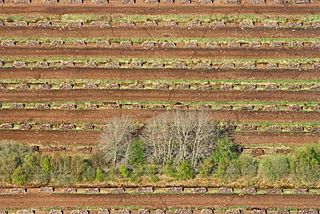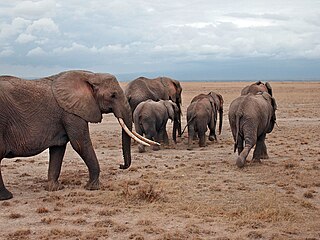Cyathea affinis is a variable species of tree fern native to Fiji, Samoa, the Cook Islands, Austral Islands, Tahiti, and the Marquesas Islands. The trunk of this plant is erect and 2–6 m tall. Fronds are bipinnate and 2–3 m in length. The rachis and stipe are pale to brown in colour, or flushed with red towards the pinnule rachis. The stipe is sparsely covered in narrow basal scales, which are pale to dark and have broad fragile edges. Characteristically of this species, the lowest one or two pairs of pinnae may be slightly reduced and occur towards the base of the stipe. Sori are located near the pinnule midvein and are partially or fully covered by indusia, which open towards the pinnule margin.
Cyathea alderwereltii is a species of tree fern endemic to Mount Sago in central Sumatra, where it is nevertheless abundant and grows in forest at an altitude of 1000–1500 m. It has an erect trunch which may be 4 m tall or more. Fronds are bi- or tripinnate and 1–2 m long. The stipe of this species is spiny at the base and covered with scattered scales that are dark brown, glossy, and have a narrow paler margin. Sori are produced near the fertile pinnule midvein and are covered by small, brown scale-like indusia.
Cyathea alpicola is a species of tree fern native to central Sumatra, where it grows in montane rain forest at an altitude of 2000–2750 m. The erect trunk can reach 5 m or more in height. Fronds are bi- or tripinnate and usually 2–3 m long. They have a tendency to persist on the plant after withering, forming an irregular skirt around the trunk. This species has a spiny stipe, which is covered with a woolly layer of scales. There appear to be two forms with different scales; either dark glossy brown with a broad paler margin and fragile edges, or small, brown and finely fringed. Sori are covered by thin, fragile indusia and occur near the midvein of fertile pinnules. The closest relative of C. alpicola is thought to be Cyathea polycarpa, which differs by lacking spines altogether. Cyathea macropoda and Cyathea magnifolia may also be closely allied with this species.
Cyathea approximata is a species of tree fern endemic to Madagascar. The trunk is erect, spiny and about 2 m tall. Fronds are bipinnate and usually 2 m long. They often form a crown of two whorls of about seven fronds each. Dark brown scales with a paler margin cover the stipe. Sori are round and occur near the fertile pinnule midvein. They are covered by thin, brown indusia, which are cup-like in appearance.
Cyathea brooksii is a species of tree fern native to Cuba, Hispaniola and Puerto Rico, where it grows on serpentine soils in shaded ravines, along streams, and on forested slopese at an altitude of 250–950 m. The trunk is prostrate and only about 6 cm in diameter. Fronds are pinnate or bipinnate and up to 2 m long. The base of the rachis is covered with blackish scales that have a paler margin. Sori occur in two rows, one along each side of the pinnule midvein.
Cyathea catillifera is a species of tree fern native to eastern New Guinea, where it grows in montane scrub at an altitude of about 2800 m and above. It is a rare plant, known only from the type locality. The erect trunk is up to about 1 m tall and 10 cm in diameter. Characteristically of this species, the trunk often branches at the base. Fronds are bi- or tripinnate, 1–2 m long and may bear a pair of reduced pinnae towards the base. There are usually around six live fronds per crown at any one time. The stipe is spiny, warty and pale on the upper surface to dark at the base. It is |covered with scattered basal scales that are glossy dark brown and have a paler margin. Stipes are persistent with bases retained on the trunk. Sori occur near the midvein of fertile pinnules and are covered by thin, brown indusia that are saucer-like in appearance.
Cyathea cucullifera is a species of tree fern native to eastern New Guinea, where it grows in montane forest at an altitude of about 2400 m. The trunk is erect and 2–3 m tall. Fronds are bi- or tripinnate and 2–3 m long. Characteristically of this species, they occur in two whorls of four to six fronds each. The stipe is warty and covered with scales. The scales are dark, glossy, have a narrow paler margin and are large towards the base. Sori occur near the fertile pinnule midvein and are covered by thin, pale brown indusia that are scale-like in appearance.
Cyathea erinacea is a species of tree fern native to Mexico, Costa Rica, Panama, Venezuela, Colombia, Ecuador, Peru and Bolivia.
Cyathea fenicis is a species of tree fern native to the Philippines, Taiwan, and Orchid Island, where it grows in wet forest, forest margins and on hillsides. The trunk is erect, up to 1 m tall and about 6 cm in diameter. Fronds are tripinnate and 1.5–2 m long. Characteristically of this species, the lowest pinnae are usually reduced. The stipe is spiny and ranges in colour from brown to purple-dark brown. It bears two types of scales: long dark brown scales as well as minute brown ones. Occasionally the scales are pale. Sori are round and arranged in two rows, one on either side of the pinnule midvein. They are covered by very small indusia that resemble scales in appearance.
Cyathea ferruginea is a species of tree fern endemic to the Philippines.
Cyathea gigantea is a species of tree fern native to northeastern to southern India, Sri Lanka, Nepal to Myanmar, Thailand, Laos, Vietnam, the Malay Peninsula, as well as central Sumatra and western Java. It grows in moist open areas at an altitude of 600–1000 m. The trunk of this species is erect and may be as tall as 5 m or more. Fronds are bi- or tripinnate and usually 2–3 m long. The rachis is long, dark to black in colouration and rough in appearance after the fall of scales. These scales are dark brown, glossy and have a narrow paler margin and fragile edges. Sori are round and indusia absent.
Cyathea gregaria is a species of tree fern endemic to eastern New Guinea, where it grows in lowland forest and coastal rain forest, often forming clumps, at an elevation of up to 100 m. The trunk of this plant is erect and usually 4–5 m tall and about 10 cm in diameter. Fronds may be bi- or tripinnate and 2–3 m in length. The stipe bears spines, but has few scales. These scales are medium brown in colouration and have a paler margin. Sori occur near the fertile pinnule midvein and lack indusia.
Cyathea heterochlamydea is a little-known species of tree fern native to the islands of Luzon, Panay, Negros and Mindanao in the Philippines, where it grows in montane forest. The trunk of this plant is erect and usually up to 4 m tall or more. Fronds may be bi- or tripinnate and 1–2 m in length. The stipe is warty and/or bears short spines and scales. These scales are dark, glossy and have a narrow pale margin. Sori are borne near the fertile pinnule midvein and are protected by firm, brown indusia.
Cyathea hooglandii is a species of tree fern native to the Western Highlands of New Guinea, where it grows in mossy forest at an altitude of about 3000 m. The trunk of this plant is erect, up to 3 m tall and approximately 10 cm in diameter. Fronds are tripinnate, 1–2 m in length and produced in two whorls of five to seven each. The stipe may be dull and warty or densely covered with scales. These scales range in colour from dark to medium brown and have a broad, paler margin as well as fragile edges. Perhaps the most distinguishing feature of this species are its sori, which are borne singly at the base of each tertiary pinnule on the midvein. They are protected by firm indusia that are saucer-like in appearance.
Cyathea metteniana is a species of tree fern native to the Ryukyu Islands, Japan, and Taiwan, where it grows in wet forest, forest margins, and on hillsides. The trunk of this plant is erect, up to 1 m tall, and 6–10 cm in diameter. C. metteniana has tripinnate fronds that are 1-2.5 m long. The stipe is brown to purple-black in colouration. It is covered in long, broad-based scales that are usually bicoloured. Sori are round, lack indusia, and occur in two rows, one on either side of the pinnule midvein.
Cyathea hunsteiniana is a species of tree fern endemic to eastern New Guinea, where it grows in rain forest at an altitude of 1300–2000 m. This species has a slender, erect trunk up to 1 m tall and about 3 cm in diameter. Fronds are bipinnate and approximately 1 m in length. Scattered scales cover the stipe. They are dark brown in colouration and have a broad paler margin and fragile edges. Round sori are borne one or two per fertile pinnule segment. The sori are protected by deep, firm indusia that are cup-like in appearance.
Cyathea ledermannii is a species of tree fern native to Papua New Guinea and Bougainville Province in the Solomon Islands, where it is common in submontane rain forest at an altitude of 1000–3000 m. The trunk of this plant is erect and grows to about 3 m in height. Fronds may be bi- or tripinnate and up to 2 m in length. The rachis is purplish brown in colouration and usually bears basal scales. These scales range from pale, to brown, to bicoloured. Sori are borne on each side of the pinnule midvein. They are protected by firm indusia.
Cyathea lepidoclada is a species of tree fern native to central and eastern New Guinea, where it is locally common in rain forest and mossy forest at an altitude of 200–1000 m. The trunk of this species is erect and usually 2–3 m tall. Fronds are bipinnate, about 1.5 m in length, and form a sparse crown. The stipe bears blunt spines and scales towards the base. These scales are glossy, dark brown in colouration, and have a paler, thin margin. The round sori are borne in groups of four to five per fertile segment. They are covered by deep, firm indusia that are cup-like in appearance.




